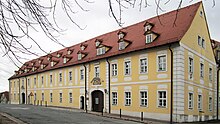Planitz Castle
Planitz Castle is a castle in the Zwickau district of Planitz , whose origins go back to the 12th century .
history
In the 12th and 13th centuries, the place was owned by the Bailiffs von Weida , who enfeoffed the Lords of Planitz with it. From 1406 they became vassals of the Margrave of Meißen . In January 1430 the Hussites raged in the village and burned down a number of farms and houses in addition to the castle. The von der Planitz family then had the castle rebuilt.
In 1572 Christoph von der Planitz had to sell the original property for 40,000 guilders to Georg von Schönburg auf Glauchau and Waldenburg , who in 1579 sold it to Joachim von Beust (1522–1597), a law professor from Wittenberg, for 40,500 guilders . The estate also included land in Cainsdorf , Wendischrottmannsdorf , Hirschfeld, Lauterholz, Wolfersgrün, Haara, Wiesen and Leutersbach. The son, Heinrich von Beust, exchanged ownership in 1617 for Schloss Netzschkau with Christoph von Reibold, who a year later handed it over to the chief chamberlain, Rudolph Apel von Vitzthum von Eckstedt , from whom the Zwickau council acquired it. Elector Johann Georg I bought the Planitz estate with Voigtsgrün in 1623. In August 1632, the imperial general Holk (1599–1633) also plundered Planitz during the occupation of Zwickau. In 1640 the Swedish riders of General Banér (1598–1641) burned down the palace and manor when they fell out of Zwickau against the imperial troops. Various pledges of the property followed.
Johann Georg III. exchanged the manor Planitz and two other chamber estates with three von Arnim brothers in 1689 for Pretzsch Castle near Wittenberg. The new construction of the castle and manor, which were now combined in a square, was tackled in 1691–1712 by Chamberlain Johann Georg von Arnim. The Arnims later mostly lived at Gröba Castle . Hans Christoph von Arnim (1736–1772) was the first of his family to take up permanent residence in Planitz in 1768. He had the southern part of the garden converted into a rococo-style pleasure garden. Between 1868 and 1872 Isolde von Arnim had the complex enlarged and converted into an English landscape garden . Georg Heinrich Wolf von Arnim (1800–1855) opened up a coal mining area on his estate in 1835. The royal Saxon chamberlain promoted hard coal mining and local industry. The founding of the Königin-Marien-Hütte in Cainsdorf goes back to his initiative.
At the end of 1933 the rule of Planitz was divided. The Planitz part with the palace and park area went to the Planitzer Sparkasse for 100,000 Reichsmarks, while the von Arnim family kept the Voigtsgrün Vorwerk until it was expropriated as part of the land reform in the Soviet occupation zone in 1945 . In March 1935, after a renovation, the castle was converted into the town hall, which also housed the savings bank. Later uses were a war hospital, then briefly a barracks for around 60 Soviet soldiers, and from around 1948 the castle temporarily served as accommodation for Bismut workers. From 1955 the castle was used as a school for the German People's Police and as the headquarters of the transport police .
After the renovation and restoration in 1991–1993, the Clara-Wieck-Gymnasium , an educational institution with a focus on music , moved into the building of the Planitz Castle .
See also
Individual evidence
- ↑ The Vorwerk Voigtsgrün at www.sachsens-schlösser.de
- ^ Norbert Peschke : The historical development of Planitz , accessed on November 30, 2012
Web links
- Website of those of Arnim
- Clara-Wieck-Gymnasium Zwickau-Planitz
- Musischer Schlossberg Planitz: Friends' Association and Foundation
- Planitz Castle on www.sachsens-schlösser.de
Coordinates: 50 ° 41 ′ 9.3 ″ N , 12 ° 28 ′ 19.8 ″ E



